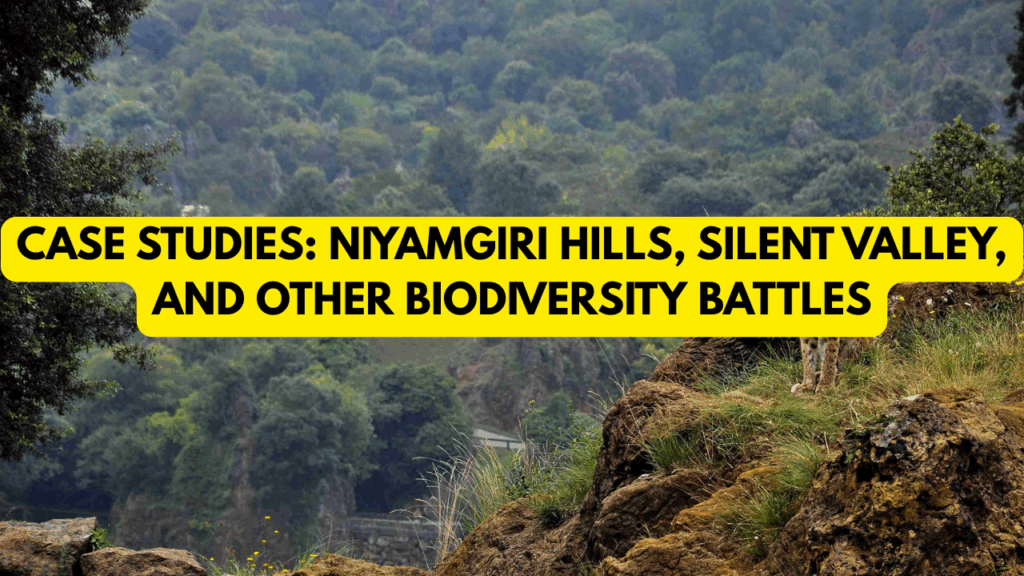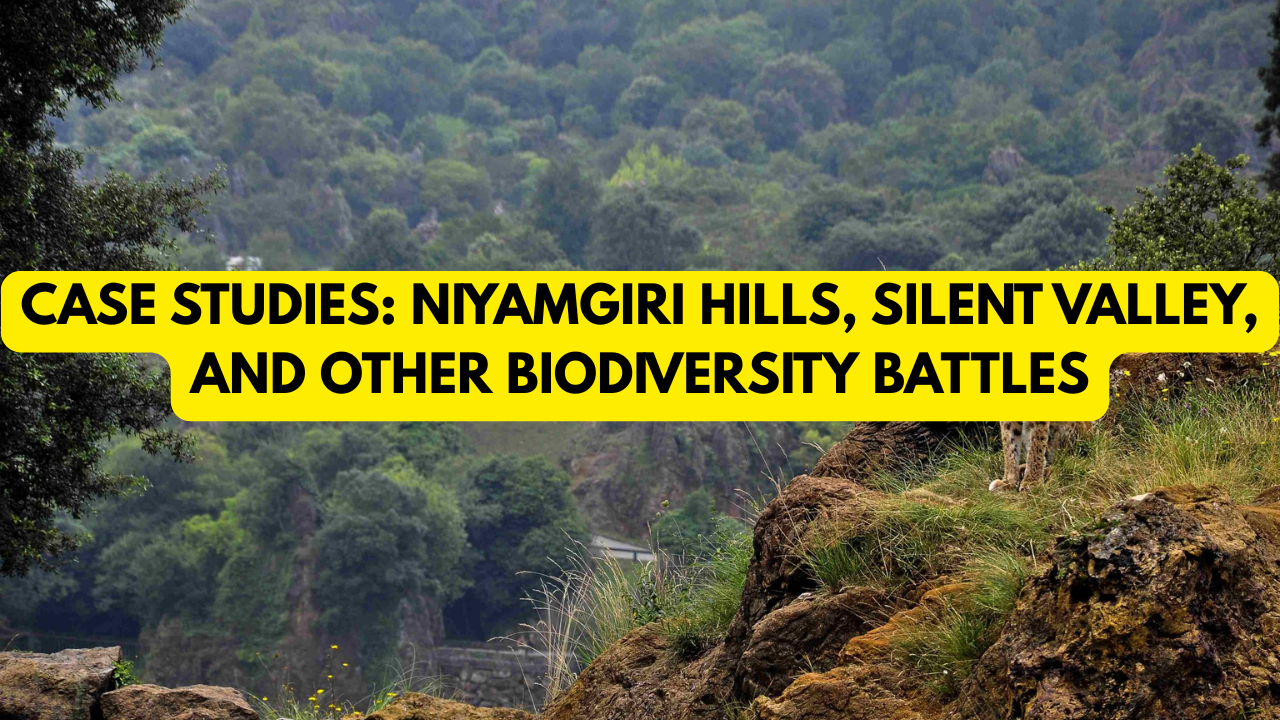
India is one of the world’s most biodiverse countries, blessed with unique ecosystems ranging from the Himalayan mountains to tropical rainforests and coastal wetlands. However, rapid industrialization, mining, and development projects have often clashed with the need to conserve biodiversity. Several iconic battles have shaped India’s environmental governance and highlighted the power of law, civil society, and local communities in protecting natural resources. Among these, the struggles around Niyamgiri Hills and Silent Valley stand out as landmark examples.
The Niyamgiri Hills Case
The Niyamgiri Hills in Odisha are home to the Dongria Kondh tribe, a Particularly Vulnerable Tribal Group (PVTG), and a biodiversity hotspot with dense forests and rare wildlife. The hills are also sacred to the tribe, forming an integral part of their cultural and spiritual identity.
- Conflict: In the early 2000s, Vedanta Resources sought to mine bauxite from the hills for its aluminum refinery.
- Concerns: Environmentalists and tribal groups opposed the project citing deforestation, wildlife loss, and violation of tribal rights under the Forest Rights Act, 2006.
- Supreme Court Judgment (2013): The Court ruled that the Gram Sabhas (village councils) of the Dongria Kondh must decide whether mining should proceed. The Gram Sabhas unanimously rejected the project.
- Significance: This case was a historic victory for tribal rights and biodiversity protection, setting a precedent for community-led conservation.
The Silent Valley Movement
The Silent Valley, a tropical evergreen forest in Kerala, became the center of India’s first major people’s environmental movement.
- Conflict: In the 1970s, the Kerala government proposed a hydroelectric project on the Kunthipuzha River, which would submerge large areas of pristine forest.
- Concerns: Scientists and activists argued the project would destroy a unique ecosystem that harbored rare species such as the Lion-tailed Macaque.
- Public Movement: Environmentalists, poets, and NGOs mobilized massive public opinion against the project.
- Government Decision: In 1983, then Prime Minister Indira Gandhi intervened and canceled the project, declaring the Silent Valley a protected area.
- Significance: This movement showcased the role of civil society in halting destructive development and inspired future environmental activism in India.
Other Key Biodiversity Battles
1. Chipko Movement (1970s, Uttarakhand)
- Villagers, especially women, hugged trees to prevent deforestation by contractors.
- Led to widespread awareness of forest conservation and influenced national forest policies.
2. Save Narmada Movement (Narmada Bachao Andolan)
- Protest against large dams on the Narmada River that displaced thousands and submerged forests.
- Brought attention to human rights, resettlement, and ecological damage.
3. Chilika Lake Protection (Odisha)
- Local communities fought against shrimp aquaculture projects that destroyed wetland ecosystems.
- The Supreme Court ordered closure of destructive prawn farms, protecting biodiversity.
4. Dahanu Taluka Case (Maharashtra)
- Battle against polluting industries in an ecologically fragile zone.
- Led to the declaration of Dahanu as an ecologically sensitive area.
Comparative Table: Landmark Biodiversity Battles in India
| Case/Movement | Issue at Stake | Outcome | Key Lesson Learned |
|---|---|---|---|
| Niyamgiri Hills | Bauxite mining vs. tribal rights | Gram Sabhas rejected mining | Community rights are central to conservation |
| Silent Valley | Hydroelectric dam vs. rainforest | Project canceled, area protected | Public movements can influence policy |
| Chipko Movement | Deforestation by contractors | Logging stopped, inspired policies | Grassroots activism is powerful |
| Narmada Bachao | Large dams vs. human/environment cost | Project partly curtailed, rehab focus | Development must balance human rights |
| Chilika Lake | Shrimp aquaculture vs. wetlands | SC banned prawn farms | Courts play vital role in ecosystem defense |
Lessons from India’s Biodiversity Battles
- Community Power: Grassroots participation ensures stronger environmental governance.
- Role of Judiciary: Courts have acted as guardians of environmental rights.
- Civil Society Movements: NGOs, intellectuals, and activists shaped national debates.
- Balancing Development and Ecology: These cases reveal the dangers of prioritizing economic growth over ecological sustainability.
- Precedent for Future Struggles: Each case strengthens the framework for environmental protection in India.
Overview Table
| Theme | Niyamgiri Hills | Silent Valley | Chipko Movement | Narmada Bachao |
|---|---|---|---|---|
| Resource in Conflict | Bauxite mining | Hydropower dam | Forest logging | River dams |
| Key Stakeholders | Tribals, Vedanta, Govt. | Govt., activists, scientists | Villagers, women, NGOs | Farmers, displaced, NGOs |
| Biodiversity Concern | Forests, wildlife habitat | Tropical evergreen forest | Himalayan forests | River ecosystems, forests |
| Outcome | Mining rejected | Project canceled | Logging stopped | Resettlement, awareness |
| Broader Impact | Tribal rights recognition | Protected area declared | Inspired green policies | Human rights in development |
Conclusion
The struggles over Niyamgiri Hills, Silent Valley, Chipko, Narmada, and others demonstrate that biodiversity conservation in India is not merely an environmental issue but also a matter of social justice, cultural identity, and human rights. These case studies highlight how grassroots activism, judicial interventions, and public pressure can reshape policies. For a country facing immense developmental pressures, these battles provide valuable lessons: true progress must protect ecological integrity and empower local communities.
FAQs
Q1. Why is the Niyamgiri Hills case significant in India’s biodiversity battles?
It recognized the role of tribal Gram Sabhas in deciding land use, strengthening both tribal rights and conservation.
Q2. What was the outcome of the Silent Valley movement?
The hydroelectric project was scrapped, and Silent Valley was declared a protected area to conserve its unique rainforest ecosystem.
Q3. How do these biodiversity battles influence future conservation efforts?
They provide precedents for balancing development with ecological protection and empower communities to resist unsustainable projects.

